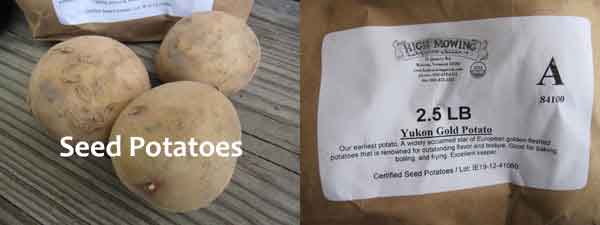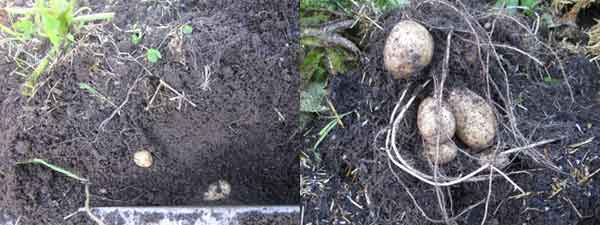Potatoes are easy to grow and adapt well to container gardening so you don't need a huge amount of space. One potato half will return eight to ten potatoes, offering a good return for time spent in cultivation. Potatoes prefer full sun and well drained, slightly acidic soil. They did really well in my sandy soil with a ph of about 6.5. The seed potatoes were planted on April 13th and harvested on July 5th just after the potatoes finished flowering. The temps never got much above 80° for the entire three months, which was perfect.
The Yukon Gold organic seed potatoes came from High Mowing Seeds, and the smallest order size was 2.5 pounds for $11. The potatoes are cut in half, so three seed potatoes yield six potato plants and each plant yields a dozen or so potatoes, so half a pound would have been plenty because there's only room for six or eight plants in my raised bed garden. And yes, Amazon does sell seed potatoes but check the quantity, variety, shipping cost, and, if it matters to you, whether they're non-gmo, heirloom, or organic.

My grandmother used to plant potatoes from the grocery store which had started to sprout, but that was a long time ago when they didn't have to say 'Shop Local!" because that's all there was. The grocer bought his produce from the local farmer and everyone knew the farmer. In today's global economy the potatoes could be shipped in from anywhere in the world and might be fertilized with any number of chemicals. In addition, some produce is sprayed with a coating to keep them looking fresh longer on the shelves. You're way better off buying seed potatoes.
Potatoes don't mind cool temps so they can be planted out a week or two before your last frost date. The seed potatoes are cut in pieces or planted whole depending on the size of the potato, but each piece needs to have at least one 'eye', so don't cut the pieces too small. Mine were cut in half and although it's not imperative, the potatoes were left out overnight to let the cut faces dry a little. The cut potato halves were planted three inches deep and twleve inches apart. The raised beds are four-feet wide so there was only one row but they need 30-36" of space if you're planting more than one row. The sprouts should appear after a couple of weeks and the potatoes need to be hilled as they start to push up out of the soil (hilling potatoes simply means mounding soil over the tops of the potatoes as they emerge). If all goes well, after a few weeks the potatoes will start to flower, and they're ready to harvest once the flowers and foliage have died back. The photo below left shows the 'eyes' the cut potatoes need to have, and the image on the right shows the potato flower.

There weren't any problems with disease, but the Colorado Potato Beetles definitely took its toll. It's surprising how the beetles found the potatoes so quickly. I've never planted potatoes before, there are no potato farms nearby, and the potato plants were under row cover right from the start until the plants got too large, which was towards the end of June. How the Colorado Potato Beetles found six potato plants in a 4' x 8' bed on a 25' x 25' plot of land is a mystery, but they found them.
We didn't want to use any sprays, so the best plan of attack was to go out every morning and evening with a cup of soapy water and scout for the beetles. It sounds difficult, but your eye gets trained to spot the striped beetles very quickly. They're very conspicuous and slow-moving so they weren't hard to find and knock into the cup. Even so, some beetles survived and the real damage comes from the grubs. The original plan was to leave the potatoes in the ground until September or October, but I couldn't stand seeing the grub damage so the potatoes were dug up on July 5th, right after the potatoes finished flowering. Even with the shortened season there was still a good harvest.
A couple of weeks after the flowers and foliage die back, dig up some of the soil, but stay away from the plant's base because although most of the potatoes will be close to the base, there will be a few that have spread outwards, and you don't want to damage the potatoes. Once dug, the potatoes need to be left in a dark, dry area in order to cure, and should be stored at temps around 40° for longer-term storage. The photo below shows the freshly dug potatoes. Btw - if you have kids, digging up the potatoes is a fun activity because it's like an Easter-egg hunt, but the kids are allowed to get dirty.
